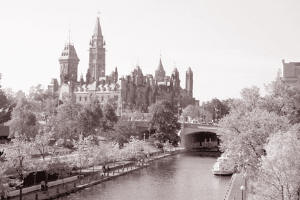Canada - forging ahead with confidence
Canada Day marks the creation of the Dominion of Canada through the
British North America Act on July 1, 1867, uniting three British
colonies-the provinces of Nova Scotia, New Brunswick and Canada.
|

The Rideau Canal and buildings of Parliament Hill
|
The three colonies united to form one country divided into four
provinces. The Province of Canada became Ontario and Quebec (see
Canadian Confederation). Canada Day is always observed on July 1 unless
that date falls on a Sunday, in which case it is officially observed on
July 2.
MAPLE LEAF FOREVER: A day off from work, Canada Day is often a time
for outdoor activities in the early Canadian summer. It is also Canada’s
main patriotic holiday and often referred to as ‚ÄúCanada‚Äôs birthday‚ÄĚ,
particularly in the popular press.
While it is the date upon which the present Canadian Constitution
first came into effect, the first day of July does not commemorate a
clear-cut date of ‚Äúindependence‚ÄĚ or ‚Äúfounding‚ÄĚ.
Instead, it commemorates the beginning of the establishment of the
Canadian confederation through the 1867 British North America Act.
The British Parliament still retained several political controls over
Canada after 1867, and the country still lacked many of its modern
provinces.
The date represents the biggest step in the establishment of Canada
as a self-governing country, and the beginning of a gradual march
towards full independence from Britain, attained with the proclamation
of the Constitution Act by Elizabeth II, Queen of Canada, in 1982.
A proclamation was issued by Governor General Lord Monck, on June 20,
1868, asking for “all Her Majesty’s loving subjects throughout Canada to
join in the celebration of the anniversary of the formation of the union
of the British North America provinces in a federation under the name of
Canada on July 1.
Dominion Day was not a particularly prominent holiday in its early
inception; in the late 19th and early 20th many Canadians continued to
think of themselves as primarily British, and were thus less interested
in celebrating a distinctly ‚ÄúCanadian‚ÄĚ form of patriotism.
Canada’s centennial of July 1, 1967 is often seen as an important day
in the history of Canadian patriotism, and Canada’s maturity as a
distinct, independent country. Post-1967, Dominion Day became far more
popular with average Canadians.
The name was officially changed to Canada Day on October 27, 1982,
largely harking back to the adoption of the earlier Canada Act 1982.
However, many Canadians had already been informally referring to the
holiday as ‚ÄúCanada Day‚ÄĚ for a number of years before the official name
change.
The celebrations in Ottawa are particularly large and lavish. Every
Canada Day, hundreds of thousands gather on Parliament Hill to celebrate
Canada’s birth. Official celebrations are held throughout the national
capital, including in Hull, with the main show taking place on
Parliament Hill.
Links:
Government of Canada:
www.canada.gc.ca
Immigration to Canada: www.cic.gc.ca
Canadian High Commission in Sri Lanka:
www.dfait-maeci.gc.ca/world/embassies/srilanka/menu-en.asp
How Canada got its name
In 1535, two Indian Youths told Jacques Cartier about the route to ‚Äúkanata.‚ÄĚ
They were referring to the village of Stadacona; ‚Äúkanata‚ÄĚ was simply the
Huron-Iroquois word for ‚Äúvillage‚ÄĚ or ‚Äúsettlement.‚ÄĚ
But for want of another name, Cartier used ‚ÄúCanada‚ÄĚ to refer not only
to Stadacona (the site of present day Quebec City), but also to the
entire area subject to its chief, Donnacona.
The name was soon applied to a much larger area: maps in 1547
designated everything north of the St. Lawrence River as ‚ÄúCanada.‚ÄĚ
Cartier also called the St. Lawrence River the ‚Äúrivi҆re de Canada‚ÄĚ, a
name used until the early 1600s.
By 1616, although the entire region was known as New France, the area
along the great river of Canada and the Gulf of St. Lawrence was still
called Canada.
Soon explorers and fur traders opened up territory to the west and to
the south and the area depicted as ‚ÄúCanada‚ÄĚ grew. In the early 1700s,
the name referred to all lands in what is now the American Midwest and
as far south as the present day Louisiana.
The first use of ‚ÄúCanada‚ÄĚ as an official name came in 1791 when the
Province of Quebec was divided into the colonies of Upper and Lower
Canada. In 1841, the two Canadas were again united under one name, the
Province of Canada. At the time of Confederation, the new country
assumed the name of Canada. |

